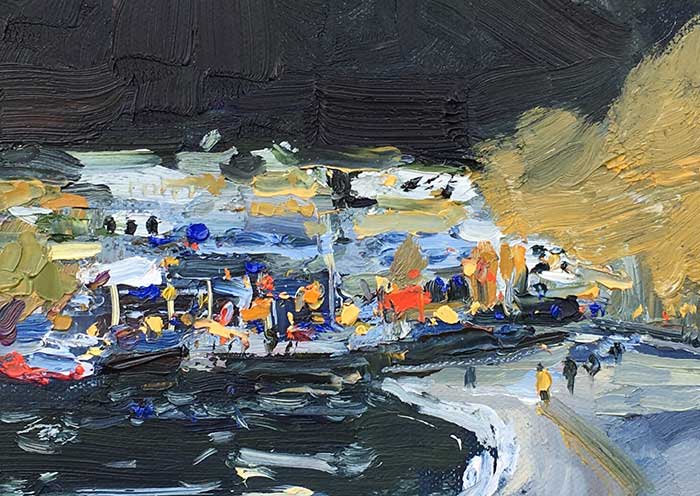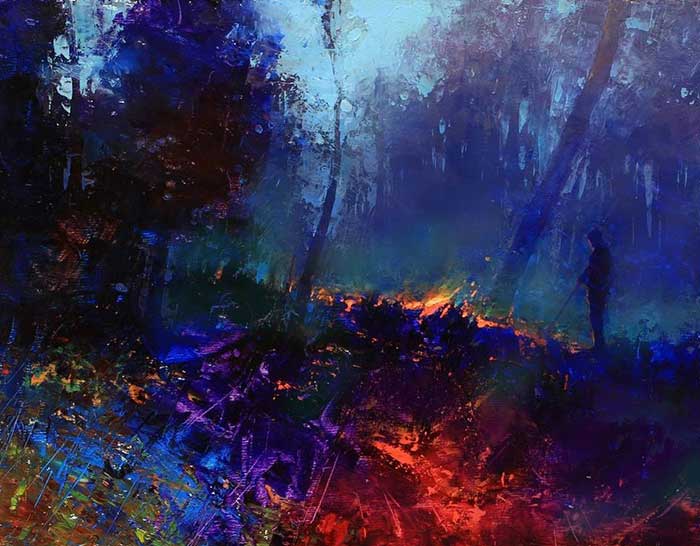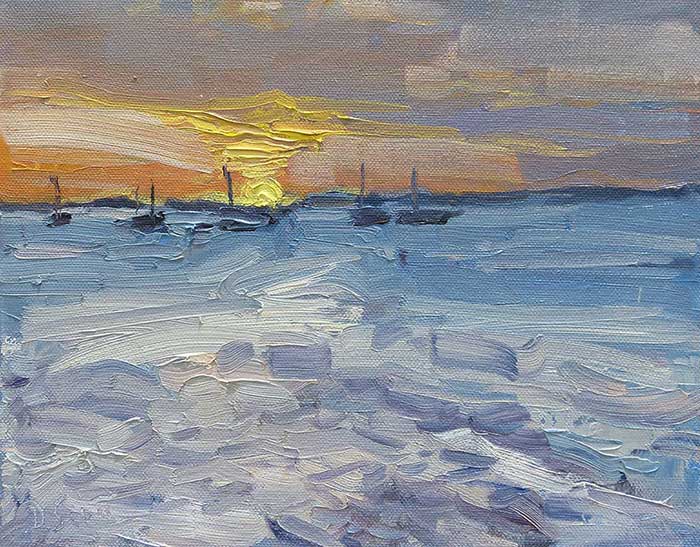what to use instead of a palette knife
The Pros And Cons Of The Palette Knife

Here are some of the pros and cons of using a palette knife for painting:
Pros:
- It is so easy to clean a palette knife. You lot literally just demand one wipe with a cloth or newspaper towel and all the pigment is gone. This is a huge advantage over brushes, which require much more intendance.
- Information technology tin can be cheap, depending on the quality of the palette pocketknife.
- Information technology is dandy for building upwards a thick texture and creating a broken color result.
- You can use the edge of the palette knife to create sharp lines.
- The bold strokes created by the palette pocketknife tin complement the more than delicate strokes created by the brush.
- Yous can paint on top of wet layers without having to worry nigh the paint blending (like it does with your brush).
Cons:
- Y'all are non able to paint with as much accuracy using a palette knife.
- It is non as versatile as a brush.
What To Look For In A Palette Knife
Below is what I expect for in a palette knife:
- A flexible simply sturdy blade.
- A comfortable handle.
- A long, straight border.
You do not need any unusual shapes. Just a standard-shaped palette knife in a few different sizes is more than than enough.
Palette Knife Techniques

Thin lines
You tin can utilise the palette knife to create sparse, unremarkably cleaved lines which can wait very natural in a painting. All yous need to do is load the edge of the palette knife with a thin amount of pigment then dab the edge on the sheet. Just make certain the pigment is evenly spread across the edge of the knife. Also, you lot will unremarkably just get one line per stroke, so you will need to continue reloading your palette knife between strokes.
You can run into Colley Whisson using the palette knife in this video to pigment the sparse line of a fence.
Dragging one color into another
The palette knife can be fantastic for blending edges by dragging i color into another. What y'all are left with is a very rough and scattered edge. If y'all were to do this with a castor, you would go a much softer border.
Scraping away paint to set errors or add details
This is where the palette pocketknife really shines. You can quickly scrape away paint from the canvass to clear an expanse where you went incorrect.
You tin can also utilize the palette pocketknife to scrape details into your painting. For example, you could scrape away a sparse line of pigment to imitate a tree branch. When doing this, you just need to exist aware of what colour will be exposed in the underpainting. Staining the canvas comes in handy here equally you will get some nice bawdy colour exposed rather than just the glaring white of the bare sheet.
Multi-colored palette knife strokes
This is 1 of my favorite techniques. Just take a few unlike colors and mix them together but non that well. And so take your palette pocketknife and create a thick stroke of broken color.
Scumbling over an underpainting
I usually prefer a brush for scumbling over an underpainting equally I feel it gives me more control, however you lot tin use the palette knife for this also. You can get some very interesting results by doing this with a palette knife.
What this involves is dragging paint very loosely over an underpainting so that the paint breaks off onto the sheet. This can be useful for calculation variance to water or grass.
Dabbing small bursts of color
This technique involves loading the tip of the knife in thick paint (unremarkably some kind of vivid color) and then dabbing it onto the painting. I utilise this technique in the later stages of a painting when I want to add a few minor bursts of color.
Beneath is a close-upwardly of one of my paintings which demonstrates this technique. Notice the small bursts of brilliant reds, blues and yellows on top of a dull foundation. This is great for creating a sense of activity, without really having to render all the details.

Cleaved color
Because the palette knife allows you to paint layer on layer without having the paint blend together, you tin can achieve some cute broken color effects which are not possible with a brush. The Russian impressionists accept reward of this in many of their paintings. The result is a vibrant display of color which virtually seems to vibrate.
(If you want to acquire more than well-nigh color, make sure to catch my gratis Color Theory Crook Sail).
Mutual Uses Of The Palette Pocketknife
Hither are some of the ways I use the palette knife in my paintings:
- To paint the highlights on rocks.
- To paint snowfall on a mountain.
- To build up texture in the foreground to imitate the grass, rocks and other nature.
- To paint the leaves or bawl on a tree.
- To quickly cover the sheet with paint.
- To paint lines for fences, tree branches or abrupt edges.
- And of form, I utilise the palette knife to mix colors on my palette and also to clean upwardly space on my palette if things start to get out of control.

Artists Who Use The Palette Knife
The palette knife seems to be gaining popularity as artists realize the benefits of information technology. Here are some artists who make skillful use of the palette knife in their paintings:
- Tibor Nagy
- Brent Cotton
- Bato Dugarzhapov
- Daniil Volkov
- Richard Schmid (especially in his blossom paintings)

Brent Cotton, Immigration The Underbrush
Creating Harmony Between Your Palette Knife And Brush
I recall the palette knife is all-time used in combination with a castor. You tin get some beautiful contrasting effects by using both in your paintings.
However, you don't desire besides much dissimilarity. You want all the elements in your painting to work together, so make sure your palette knife work is somewhat in harmony with your brushwork.
A technique I oftentimes utilise is to soften the edges of whatever palette pocketknife strokes with my brush or run my palette knife over visible brushwork. This can create a subtle connectedness between the palette knife piece of work and brushwork.
You should besides make sure there is either a authorisation on palette knife work or brushwork. Y'all probably shouldn't employ both equally throughout your painting as it may await slightly confusing.
If I utilise mostly palette knife work in my painting, I could incorporate small-scale areas of visible brushwork to intermission things upwards. On the other mitt, if I generally utilise brushwork, I could break things upward with pocket-sized areas of thick palette pocketknife strokes.
But remember that yous need all the elements in your painting to work well together. There is no point having some beautiful strokes of color in your painting from a palette knife if they practise not fit with the residue of the painting.
My painting below is a demonstration of both palette knife work and brushwork. I used the palette knife to build up that thick texture on the sail, particularly for the sun. I used the castor to add some of the effectively details.

Sunset Report, Kingfisher Bay, Oil, 10x12 Inches, 2017
Full general Palette Knife Painting Tips
Here are some general palette knife painting tips:
- Make sure to clean your palette knife after yous take finished. If you forget, the paint will dry and your palette knife will be nigh worthless (as it will have a crude border). You might be able to salvage your palette knife by scraping the dried paint away with a razer, just sometimes this is merely not worth the hassle.
- Don't become too regular with your palette knife strokes. Try to mix things up in terms of stroke length, colour or texture.
- You don't need all the unusual palette pocketknife shapes. You merely need a few sizes of standard-shaped palette knives.
- The palette knife tin can scrape away paint simply equally easily as it can apply pigment.
- The palette pocketknife comes at the cede of accurateness and intricate brushwork, so try to brand up for it with stunning use of color.
- The palette pocketknife is slap-up for sharp shifts in color. For example, if you desire to indicate some sunlight peering through a dark cluster of trees, the palette knife would be great for this.
Palette Knife Sets
Here are some popular palette pocketknife sets:
Source: https://drawpaintacademy.com/palette-knife-painting/
0 Response to "what to use instead of a palette knife"
Post a Comment